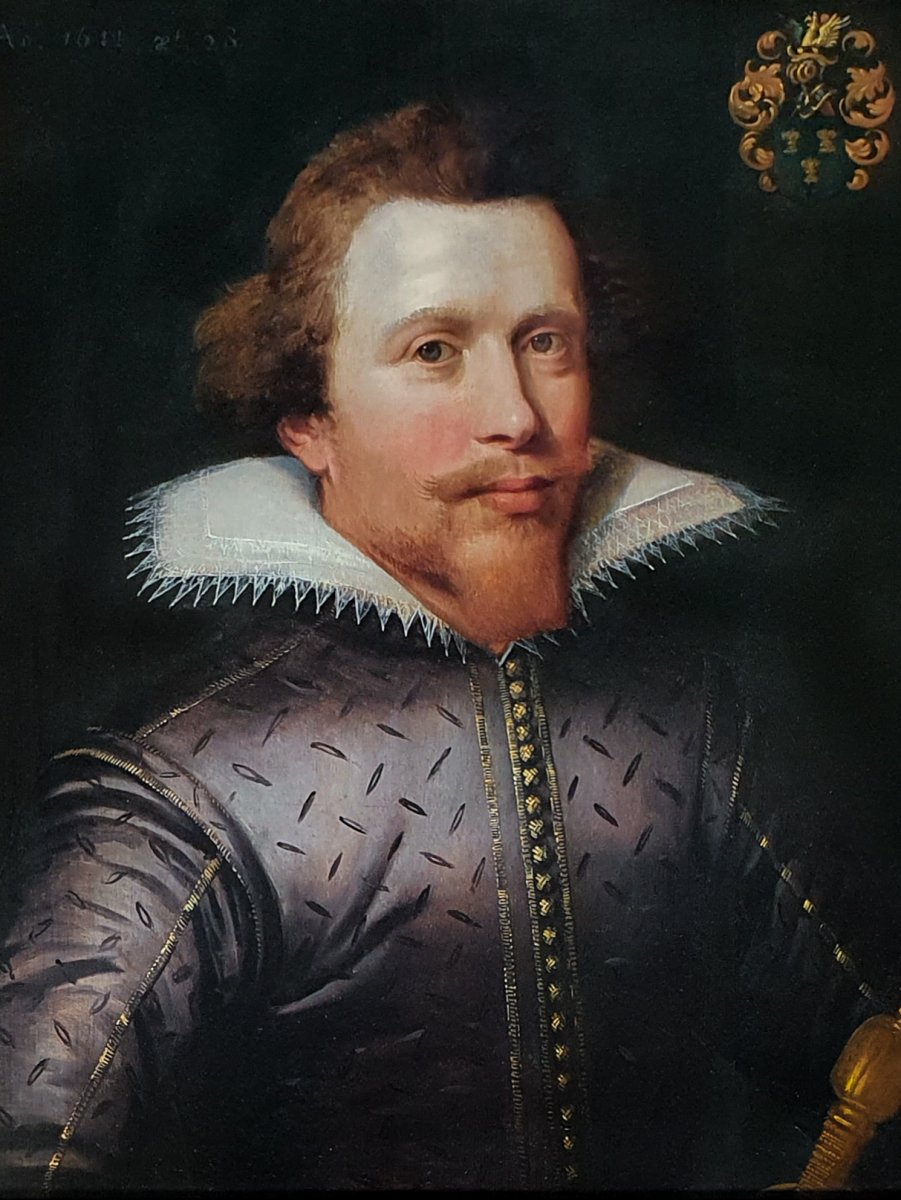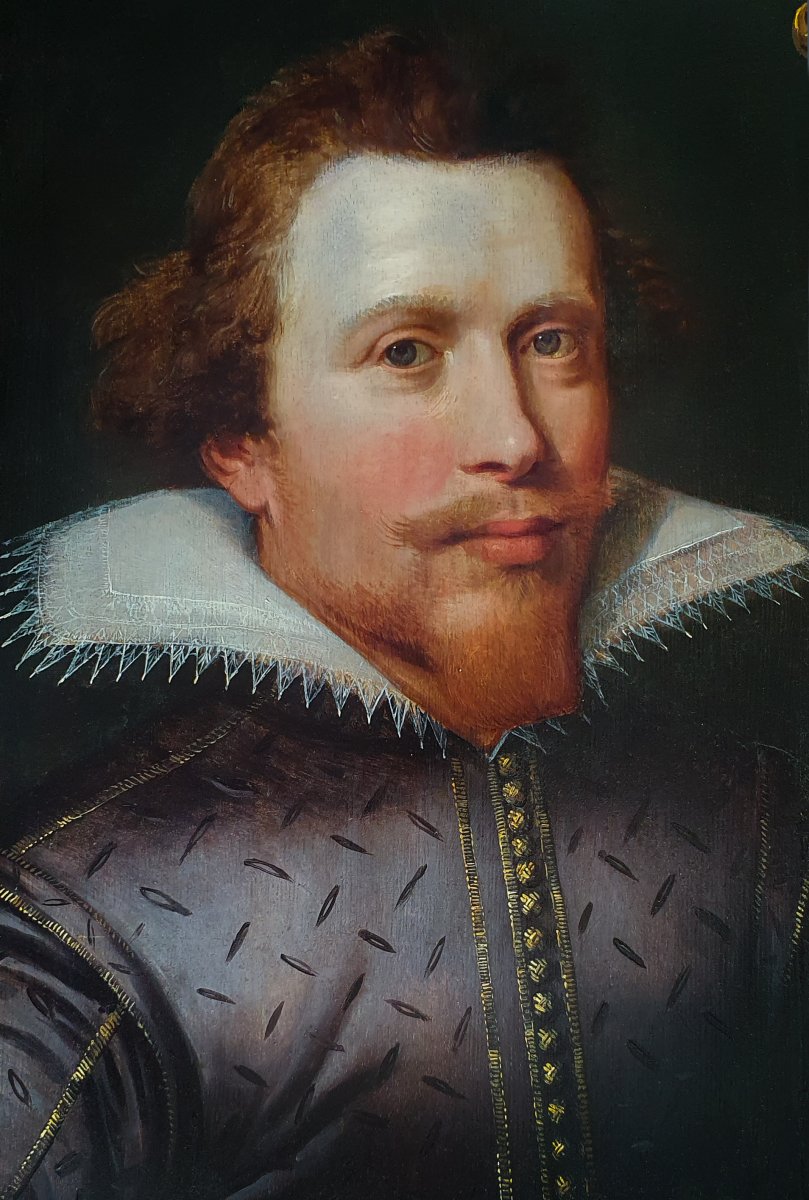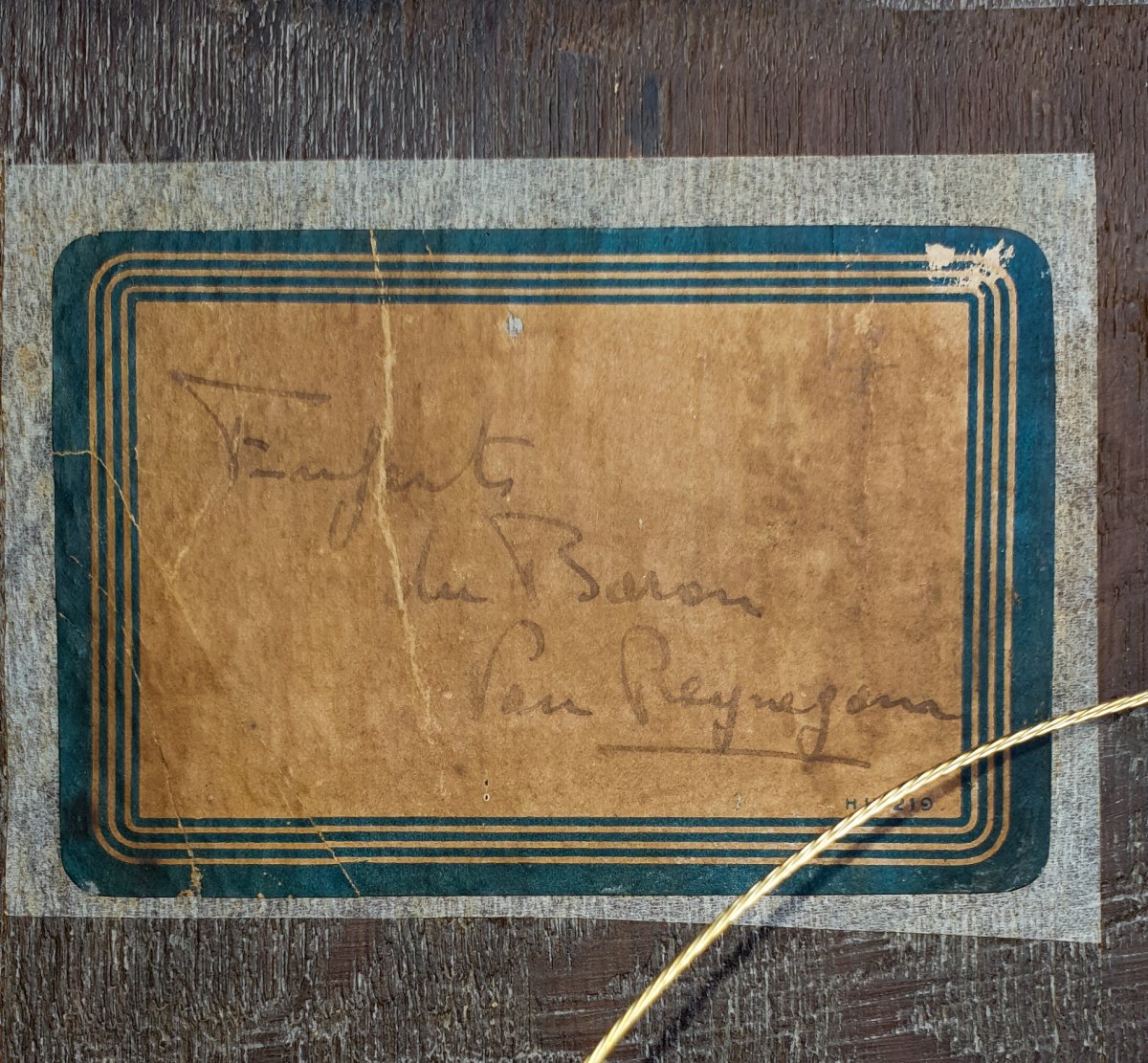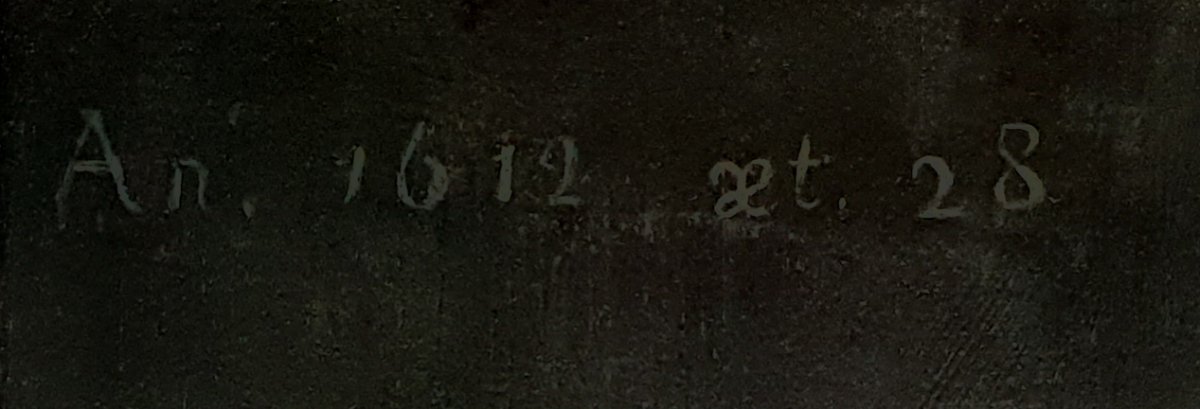"Portrait Of Jan Van Reynegom (1584-1640) Date 1612, Circle Jan Anthonisz. Van Ravesteyn"
Portrait of Jan van Reynegom (1584-1640) dated 1612Circle of Jan Anthonisz. van Ravesteyn (c.1572-1657)
This striking panel portrait depicts a handsome gentleman wearing a white collar and elaborate satin coat with gold trim down the front. The extraordinary costume with its shimmering quality and costly fabrics and lace was an important marker of the wealth and status of the wearer and speaks of the status of the sitter in Dutch society. Details of dress in Dutch formal portraits are usually faithful reflections of the sitter's own clothing and artists portrayed their clients in the manner set out by the terms of the commission. They were almost always intended to convey the sitter’s social status and rank in society. The expensive fabrics, the attire, and the grand coat-of-arms as seen in the present portrait proclaim to every onlooker that this is a superior being. It is a fine example in its description of the sitter’s character.
The portrait depicts Jan van Reynegom (or in French, Jean de Reynegom), an ancestor of current Belgium nobility. The Van Reynegom family were a very rich family of brewers known from the fourteenth century in Gouda, Zuid-Holland. Later the family played an important role as the hereditary owners of the stewardship of Naaldwijk. The manor of Naaldwijk was owned by several noble families. The Van Reynegom family worked for the counts of Arenberg.
According to the inscription the sitter was in his twenty-eighth year when the portrait was painted in 1612. This would imply that the man in the painting was born in 1584. Jan was born on 18th January 1584 and was the sixth child of Cornelis van Reynegom (1538-1616) and Josina van Hoof (1548-1618). He had ten siblings, all born between 1577 and 1592.
Jan was intended to succeed his father as the steward of Naaldwijk however, because of his Catholic faith, he was not allowed to perform this function and was deprived of this office on grounds of religion by sentence on May 8, 1608. Later, he became Bailiff and President of the water board of Sint Anna Polder, near Hulst. He never married and died on 2 June 1640. He was buried in the church of Kallo, near Antwerp. A portrait like this certainly suits a person of his considerable origin and position. A painting exists of the Gouda militia in 1599 and in it is the Lead of the militia, Colonel Jan Dircksz van Reynegom (buried in Gouda in 1606), who is the sitter’s uncle.
The portrait is charged with the van Reynegom Coat of Arms, which is described in genealogical documents from Brussels as: ‘Azure with three rooks, set in gold' and has as its motto: 'Rien sans émuer - Nothing without a heart' (rooks are the towers in the game of chess). The noble family of Reynegom still exists, now in Belgium, and are members of Belgium nobility. They exist in two branches: van Reynegom de Buzet and van Reynegom d'Hectvelde and carries the title of baron.
The century from the conclusion of the Twelve Years’ Truce in 1609 until either the death of Prince William III in 1702 or the conclusion of the Peace of Utrecht in 1713 is known in Dutch history as the “Golden Age.” It was a unique era of political, economic, and cultural greatness during which the little nation on the North Sea ranked among the most powerful and influential in Europe and the world. Dutch explorers charted new territory and settled abroad. Trade by the Dutch East-India Company thrived, and war heroes from the naval battles were decorated and became national heroes. In the second half of the 17th century the Dutch merchant fleet equals that of England, France, Spain and Portugal combined. And Dutch wages are the highest in Europe, some 20% above the equivalent in England.
During this time, The Dutch Old Masters began to prevail in the art world, creating a depth of realistic portraits of people and life in the area that has hardly been surpassed. The Golden Age painters depicted the scenes that their discerning new middle-class patrons wanted to see. This new wealth from merchant activities and exploration combined with a lack of church patronage, shifted art subjects away from biblical genres. Still lifes of items of everyday objects, landscapes, and seascapes reflecting the naval and trade power that the Republic enjoyed were popular. The new wealthy class were keen to have their portraits commissioned and thus many artists worked in this lucrative genre.
The burgeoning middle classes, with their disposable income, meant that almost everyone was an art collector. Such high demand resulted in the flooding of the market, which in turn had important artistic consequences: artists became increasingly specialised in both quality and subject matter. Considering these factors, artists could become very wealthy according to their business sense, while many had to depend on a second profession to provide an income.
Most of the Dutch elite were wealthy townsmen whose fortunes were made as merchants and financiers, but they frequently shifted their activities to government, becoming what the Dutch called regents, members of the ruling bodies of town and province, and drawing most of their incomes from these posts and from investments in government bonds and real estate.
Jan Anthonisz. van Ravesteyn was a very successful portraitists to the Dutch court in the Hague - the city which was both the seat of government and home to the Stadholder’s court, these were drawn from the ranks of wealthy courtiers, and senior government and military officials, as well as from foreign visiting diplomats and delegates from all over the Dutch Republic. He registered with the Guild of St. Luke in The Hague in 1598 and remained in the city for the rest of his life. He married Anna Arentsdr. van Berendrecht, the daughter of a prominent Dordrecht regent family, in the Town Hall in The Hague. The fact that the marriage was conducted in the Town Hall suggests that the painter was a Roman Catholic, as was the sitter in our portrait, an indication confirmed by later references in documents.
Although very few of his early works survive, he had clearly established himself as a painter of repute by 1604. He succeeded in maintaining his position as one of the city’s leading portraitists for much of the first half of the seventeenth century, despite stiff competition from Michiel van Mierevelt (1567-1641), who worked in nearby Delft, and later from the Utrecht painter Gerrit van Honthorst (1592-1656).
His most prestigious commissions included a series of twenty-five portraits of high-ranking military officers from the Stadholder’s court, now in the Mauritshuis, The Hague, a portrait of Prince Frederick Henry of Orange Nassau, in the Dutch Royal Collection, and several very large group portraits of militia companies. The artist also produced a number of children’s portraits, which are not only among his finest works, but are considered to be among the outstanding examples of the genre.
Provenance: Private collection Belgium
Measurements: Height 78cm, Width 65cm framed (Height 30.75”, Width 25.5” framed)



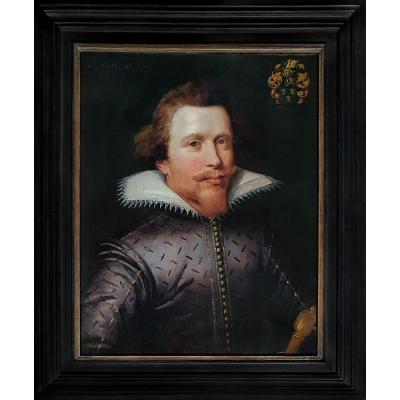





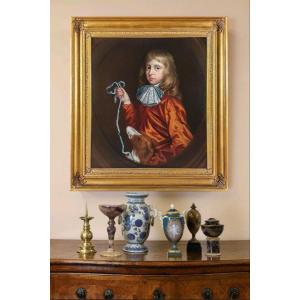
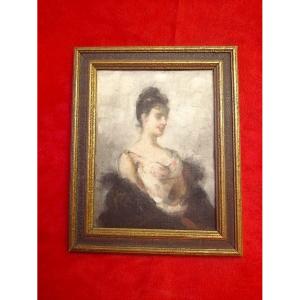
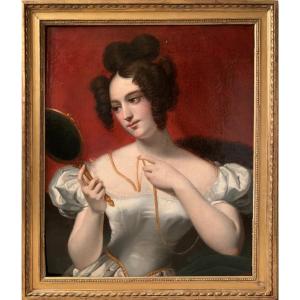
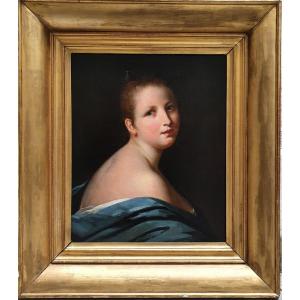

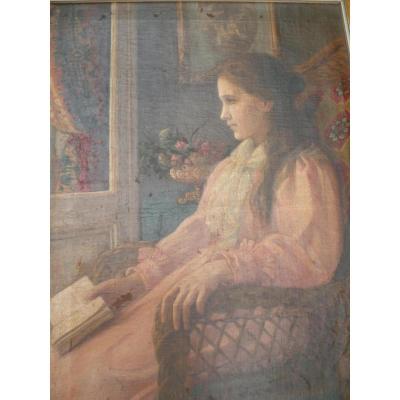





 Le Magazine
Le Magazine Rivista Artiquariato
Rivista Artiquariato TRÉSORS magazine
TRÉSORS magazine

